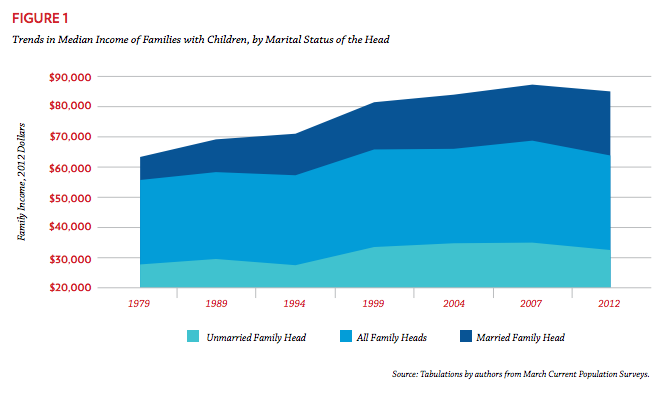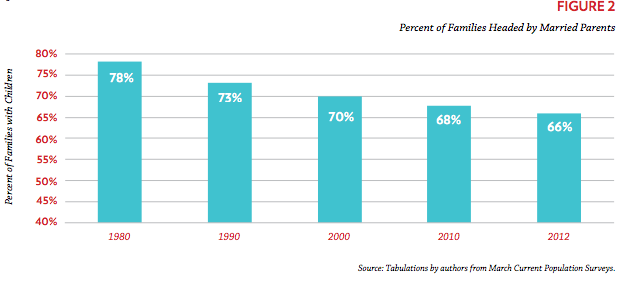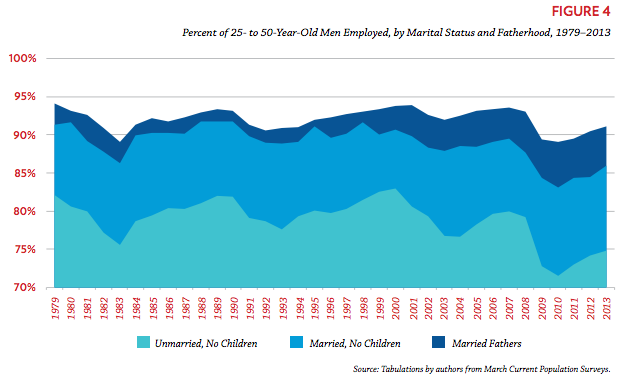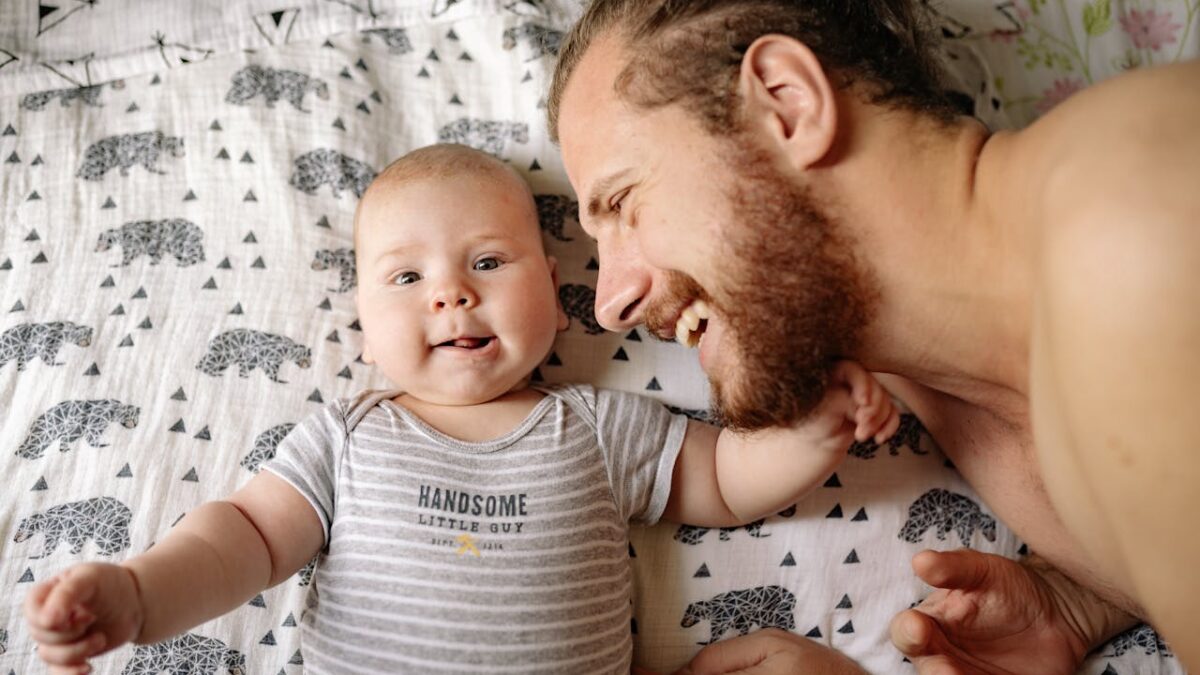
If you care about the poor, you need to start caring much more about marriage culture. The growing marriage divide is a major source of social and economic inequality, and is one largely unnoticed force eroding the American Dream. That’s the sobering message of a new report on economic success and marriage decline.
Americans with college degrees are doing pretty well on the marriage front. They get married and stay married. But the picture is very different for Americans with lower education levels. Lower income Americans are being hit hardest by changing social norms, the rise of the post-industrial economy and the retreat from civil society and its institutions. That’s creating a marriage divide among Americans that is leading to serious inequalities, say the Urban Institute’s Robert Lerman and the University of Virginia’s Bradford Wilcox.
Lower-income Americans have been steadily retreating from marriage and that move has played a key role in their declining economic fortunes, the scholars write in “For Richer, For Poorer: How Family Structures Economic Success In America.” The duo estimate that median income growth of families with children would be 44 percent higher if people were marrying at 1980 levels. Further, at least 32 percent of family income inequality and 37 percent of the decline in men’s employment rates since 1979 can be linked to the decreasing number of Americans who form and maintain stable families.
“All the latest evidence confirms the ancient wisdom: the institution of marriage is a key to productive adulthood, the cornerstone of a stable family, and the basic unit of a healthy community,” says American Enterprise Institute president Arthur Brooks of the new study.
Stable family formation is good for men, women and the children they have. Growing up with both parents is strongly associated with more education, work and income among young men and women. They enjoy an annual “intact-family premium” of $6,500 and 4,700, respectively, over children of single parents.
Men in particular do well with marriage, in terms of their income, and both men and women enjoy substantially higher family incomes when they’re married, compared to peers with otherwise similar traits. Men enjoy a whopping marriage premium of at least $15,900 each year in income compared to single peers. The family premium for men and women who are are married and were raised by married parents is some $42,000 over unmarried peers who weren’t raised in intact families.
What’s interesting is that growing up with both parents increases your economic success and that, in turn, leads to higher odds of being married as an adult. Added education and marriage result in higher income levels.
And the advantages of a strong marriage culture apply about as much to blacks and Hispanics as to whites, the report’s authors state. Black men have a marriage premium of $12,500 in individual income. And this bonus works for men and women who are less educated as well. Men with a high school degree or less still have a marriage premium of $17,000 compared to single peers.
It can’t be that simple, can it?
Actually, it’s not that simple. The report’s authors are the first to admit that connections between the economy and patterns of family life are complex. One could argue that it’s the bad economy for less-educated workers that’s leading to economic insecurity and declines in marriage and that these are then leading to poor educational, job and family outcomes for kids. Or one could say that the the declining propensity to marry, along with changing social norms about its desirability prior to childbirth, have led to declines in stable families and that these declines have exacerbated problems of poverty, increased inequality and lost shots at economic mobility. The report’s authors suggest that both arguments are valid and need addressing.
The Shifting Economic Fortunes of American Families
Having or raising children out of a stable marriage is associated with dramatically different income levels, as this chart shows.

Here we see the decline in marriage for couples with children.

The authors note that married families enjoy greater economies of scale and receive more economic support from kin, and married men work harder and earn more money than their peers, all factors that give them an economic advantage over cohabiting and single-parent families. “The decline, then, in the share of married parents is one reason why American family incomes have been relatively stagnant since 1979,” they say.
Some might note that the incomes are really a mark of how elite Americans are marrying more than non-elites. But the authors said that if you control for “race, education, and Hispanic descent, had the share of married parents remained at 78 percent in 2012, the rise in the overall median income of parents would have been about 22 percent, substantially more than the actual growth of 14 percent.”
A word about men and women
For whatever reasons, marriage really seems to transform men for the better in ways that are beneficial to those around them. They work more hours, they work more strategically, they earn much more money, and they do this even in an era that is far more egalitarian than previous eras. There is some kind of power in marriage for men.
This chart shows that recent decades’ decline in employment is most noticeable for single men.

For women, the story is good but in different ways. Marriage exacts no penalty on women’s personal income and it yields a substantial increase in family income. Any penalty associated with workforce disruptions of motherhood is lowest for married mothers. And the difficulties of single parenthood on women in particular are dramatic. Having stable, committed partners is hugely helpful for both men and women.
Retreats from institutions
Much has been written about the idea that Americans are increasingly disengaged from institutions of work and civil society. But the effects are particularly strong for less-educated Americans, and especially men. Civil and religious institutions have traditionally supplied money, moral direction and social support to marriage in America. Lower-educated Americans have always been less involved in civil institutions but the declines are even more noticeable in recent years.
In the 1970s, around half of people with no high school diploma and 86 percent of those with college degrees were involved in non-religious civic organizations. In the 2000s, those percentages dropped to 22 percent and 77 percent, respectively.
In the 1970s, one third of Americans with no high school diploma and 38 percent of those with college degrees reported weekly church attendance. In the 2000s, those percentages dropped to 23 percent and 34 percent, respectively. And for those with a high school diploma but no degree, they dropped from 40 percent reporting weekly attendance to only 28 percent.
Working-class and poor men are increasingly disconnected from full-time work, from family structures and from secular and religious organizations. Some scholars say this translates into less responsibility in life and relationships.
The bottom line
The report’s authors say that the marriage chasm is “rooted in cultural, economic, and civic changes that have undercut the normative, financial, and communal bases of strong and stable marriages and families in poor and working-class communities.”
They recommend a number of campaigns to address those problems. They say that civic and cultural institutions should emphasize “success sequences,” where young people are encouraged to finish high school, work, marry, and then become parents. They further say that Americans need to think especially hard about reaching less-educated men.
They recommend that policymakers should “eliminate or reduce marriage penalties embedded in many of the nation’s tax and transfer policies designed to serve lower-income Americans and their families.” They say federal and state policy should “increase the child credit to $3,000 and extend it to both income and payroll taxes; expand the maximum earned income tax credit for single, childless adults to $1,000, increasing their marriageability; and expand and improve vocational education and apprenticeship programs that would strengthen the job prospects of less-educated young adults.








